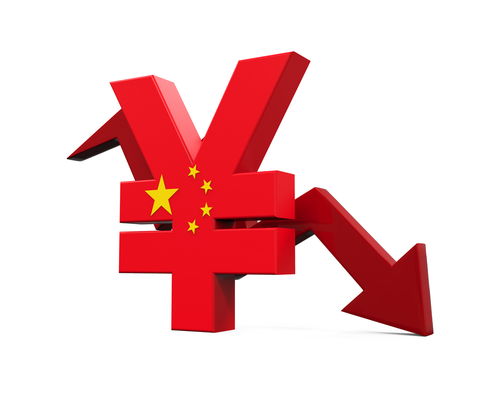Volatility. Demand redefined. Economic markets plummeting. D aily we see the financial charts roll across the news.
aily we see the financial charts roll across the news.
“It’s partly about growth, partly about trade, and partly about psychology.” CNN Money – August 12, 2015
On Tuesday and Wednesday, the Chinese restated and devalued the Yuan. The new valuation and its impact is swinging the global stock markets. The water cooler is buzzing. The discussions on 401K losses of 10-13% permeate the office. News anchors broadcast real-time data on the stock market, and while there are many commentaries on the positives and the negatives, what is clear is we are in a period of change and uncertainty.
Markets drive supply chains. As the markets plummet, it is time to remind ourselves that demand is not a forecast. Traditional forecasting approaches are not adequate in a time of market volatility.
The supply chain needs to respond to market demand and consumer sentiment. Traditional supply chain processes do not sense. They respond. This is a major disconnect.
Shifts in market demand, and the response to volatility, define winners and losers. For supply chain leaders, this market downturn defines a new set of opportunities and risks. My question is, “How many economic downturns will supply chain leaders experience before they get serious about market sensing?” Today, I know of less than 25 companies that actively sense demand; and while we talk about the use of channel data and the building of demand sensing processes to use channel data, it is still an elite group of supply chain leaders that are perfecting the techniques. Vendor Managed Inventory processes–once hailed as the panacea of demand sensing–largely operate in isolation within sales organizations (of the 33 organizations that we interviewed last year, no market leader has connected these demand signals). Demand processes are evolving.
In the real world, companies operate with a Mean Absolute Forecast Error of 24-60%, and have a bias of 9-40%. Many organizations will play the shell game of reporting forecast error so that the numbers look better: either calculating the forecast at a higher level in the forecast hierarchy (not at the item level) or reporting the data as a Weighted Mean Absolute Error. This gives supply chain leaders a false sense of security. Leaders feel that they are adequately buffered against the market. They are not.
Reflection
I remember December 2007 like yesterday. It was a cold, crisp winter in Boston. On my walks to the hotel from the office at AMR Research, I wrapped my scarf tight on my head and fought the brisk harbor winds freezing my face. My feet slipped and slid on the icy sidewalks. However, it was the stark reality of the economy that was my wake-up call.
During that winter I was staying at the Westin in Boston and working remotely. While on most days it is hard to book at this hotel since demand is higher than the supply of rooms, during this period the room occupancy was so low that they shut down the restaurants. There was no room service. The hotel was empty: steps on the hotel lobby’s tile floor echoed down the hallway. The downturn in consumer spending was frightening. While my parents had shared their stories on the market fall in the wake of the depression in the 30’s, this was the most marked economic downturn that I had experienced.
On the second week of December, I quickly changed my calendar to visit with a team of economists at DuPont. I laughed as I entered the room with seven gray-haired, seasoned economists. While I took many years of economics classes in business school at Wharton, let the record state: I am no economic expert. As I opened the door, I questioned, “Who was I to advise economic experts?” Their questions peppered the dialogue like machine-gun fire. They wanted to know, “How was the market affecting the chemical supply chain?” They questioned, “How long will this recession last? And, what will signal an upturn?” The team needed to make a decision on when to shut down their plants, the right levels of inventory to build during the plant closure, and how to predict the duration of the downturn. However, most importantly, they wanted to understand how to sense the market upturn. They knew that the profit opportunity was sensing the rebound and readying the supply chain for the uncertain future. As we traced the process that could exist using channel data, the conversation changed.
DuPont served two primary markets–automotive and the building industry. Both of their primary markets were spiraling in a serious downturn. Smiling, I shared insights on the data available in the market to sense true market demand and the principles of the bullwhip effect as shown in Figure 1. The irony is that there is more market data available on true customer spending with less latency than ever before. However, only 5% of organizations are using market data. It is ironic because we can now read markets in days not months, and the data availability has never been higher. The problem is that traditional processes do not use it. Instead, we forecast using traditional methods: we do not sense markets.
Why is this important? DuPont as a chemical supplier to the market sits four to five levels back in the supply chain with extreme demand latency (about six months) and high volatility of the true market demand signal due to the bullwhip effect. While traditional forecasting approaches use statistics to model history, assuming that historic shipments and order patterns represent future market patterns, in the times of market volatility, especially for manufacturers two to five levels back in the supply chain, traditionally forecasting is not adequate. Market downturns are a consistent reminder of this fact.
I recently listened to a DuPont presentation on their supply chain redesign. The stated goal is to be more demand driven. Despite the impact of the last downturn on DuPont’s supply chain there are no initiatives to improve demand sensing. Instead, the presentation focused on making traditional processes move faster. Like a goldfish’s memory, the organizational response to market downturn is short-lived.
Figure 1: The Bullwhip Effect

When there is a market downturn, traditional organizational behavior buffers market reality. Within a company, good news travels fast and bad news moves slowly. Denial reigns. When shipments slow, marketing and sales programs go into overdrive. Functional reward systems delay the needed response.
While the macroeconomic signals trigger market downturns, to meet Wall Street expectations manufacturers usually push products into the channel. This can only be sustained for one to two quarters before companies have to admit to themselves that they are facing a market downturn. No matter what companies do with sales and marketing programs, the market reality slowly permeates the fiber of the organization. They must finally admit that the market demand is down. This can take weeks, even months.
With global, intertwined supply chains of 25-100 weeks, putting the brakes on the supply chain and slowing down supplier contracts and shipments is difficult. The longer the company takes to sense the market reality, the bigger the impact on costs, write-offs and customer service.
As a result, ever so slowly, in traditional processes, the market volatility translates to parties in the supply chain. The irony is that consumer data has never been more available. The sad reality is that data and information can travel faster than organizations can believe the information and equilibrate to a new market reality. It is hard for an organization to move through the denial cycle and believe it is time to act.
The Here and Now
So, as the market reality of the current volatility settles into your company, I think it is a good time to reflect. Could the market downturn be a good time to do an upturn and fuel a project to focus on demand sensing? I think that we have a burning platform. Here are some facts to consider as you build your case:
1) Market Volatility Has Never Been Higher. Bing. Bang. Boom. The hits keep on playing. First it was the downturn in Southern Europe, followed by the economic crisis in Greece and now the devaluation of the Yuan. The global economy is slowing, and volatility is rising.
The inherent buying patterns of consumers are also changing. Purchases in the center aisles of the grocery store are in decline, and apparel tastes are shifting. There has never been a better time to think about reduction of demand latency and using market signals to sense demand. (For more on this topic, reference my prior blog posts on Learn the Language of Demand and Driving Innovation )
2) Product and Customer Complexity Is Higher and Forecastability Is More Difficult. Over the past five years, it is harder and harder to forecast a product line? Why? With the increases in items, and the number of market events, the forecastability–the ability of a statistical engine to pick up an accurate pattern in historical data–is becoming worse. As a result, for companies that calculate MAPE and are diligent about tracking forecast data, they are seeing a steady increase in demand error.
3) Too Few Companies Have Discipline in Forecasting Processes or Measure Forecast Value Add. Organizational DNA is defined by supply. Too few companies have the discipline to measure Forecast Value Add–comparison to the naive forecast–and drive improvement. In supply chain demand benchmarking we see serious degradation of the forecast in lag 1 (30 days in the future) versus lag 3 or 4 (or 90 and 120 days in the future), due to the inclusion of sales data in management overrides. While collaborative forecasting sounds like a good idea, we have found it is not. The direct coupling of sales forecasting through CRM technologies usually degrades the forecast based on the high bias and error associated with input from the sales team. The sad fact is that if you have four people sitting at the table reviewing the forecast–a sales person, a marketing team member, someone from manufacturing, and someone from finance–the highest bias and error will come from the sales team. Why? Incentives drive organizational behavior. The second highest bias and error will come from marketing.
4) Internal Cooperation Is Essential. While companies can predict an event, they struggle to predict the timing of an event. Demand translation and demand latency help to sense the timing of market events. It is both an art and a science. To accomplish this, it is critical and essential to develop collaborative workflows, and the use of channel data helps to see the flows from the channel partner’s warehouse to the point of purchase. Sensing the channel is critical to match manufacturing flows to the channel.
5) Tightly Integrated Global Supply Chains Need a Quicker Response. The supply chains are more complex today than a decade ago. There is more in-transit inventory–sitting on the water in larger ships, in-transit through international sourcing strategies, or work with contract manufacturers– and as a result, to avoid inventory write-offs, the foot needs to hit the brake faster. This is all about demand sensing and organizational alignment. I am working with one company at the moment that is sensing the downturn, but cannot get the organization over the denial stage to take action. It takes both the technology and the organizational DNA to have the right stuff to make a difference.
6) Rethink Traditional Demand Planning. Focus on Sensing Using Independent Demand. Most traditional demand planning implementations focus on the use of statistical modeling to predict demand based on order demand. The focus is on the translation of order demand to distribution centers. The order is not a good representation of demand, and the rules-based consumption logic to translate order demand to a distribution center is woefully inadequate.
In this time of volatility, it is important to remember that all orders are not equal. An order is not an order. Lacking visibility, the order stream lumps all orders together with no visibility of rush orders, turn orders, custom orders, or orders stuffing the channel to help sales meet their numbers
By building demand management processes to focus on channel movement, companies can cut demand latency and model independent demand–customer purchases. This decreases the bullwhip effect and helps companies to better synchronize with markets. So why have companies not done this? Simply put, it is expensive. The shift requires tight alignment with sales, and the change flies in the face of tradition. However, in this time of market volatility, it is time to rethink and challenge traditional forecasting approaches.
I hope that this market correction can help us to redefine demand management. Building outside-in processes flies in the face of the traditional inside-out processes, and may take awhile to develop and perfect. What are your thoughts? I would love to hear from you.
Confused? Need help? We will be discussing these and other issues at the Supply Chain Insights Global Conference on September 9th and 10th. If you have not registered, please do so quickly. I designed the agenda to help supply chain leaders rethink the future in a deeper way than any other conference agenda that I see in the market. We will also be announcing the 2015 winners for the Supply Chains to Admire analysis which analyzes company progress on both supply chain performance and improvement on the Metrics That Matter for the period of 2006-2014. We hope to see you there!
_____________
 Life is busy at Supply Chain Insights. We are working on the completion of our new game—SCI Impact!—for the Supply Chain Insights Global Summit in September. We would love to see you there! Our goal is to help supply chain visionaries around the world break the mold and drive higher levels of financial improvement.
Life is busy at Supply Chain Insights. We are working on the completion of our new game—SCI Impact!—for the Supply Chain Insights Global Summit in September. We would love to see you there! Our goal is to help supply chain visionaries around the world break the mold and drive higher levels of financial improvement.
About the Author:
 Lora Cecere is the Founder of Supply Chain Insights. She is trying to redefine the industry analyst model to make it friendlier and more useful for supply chain leaders. Lora wrote the books Supply Chain Metrics That Matter and Bricks Matter, and is currently working on her third book, Leadership Matters. As a frequent contributor of supply chain content to the industry, Lora writes by-line monthly columns for SCM Quarterly, Consumer Goods Technology, Supply Chain Movement and Supply Chain Brain. She also actively blogs on her Supply Chain Insights website, for Linkedin, and for Forbes. When not writing or running her company, Lora is training for a triathlon, taking classes for her DBA degree in research at Temple or knitting and quilting for her new granddaughter. In between writing and training, Lora is actively doing tendu (s) and Dégagé (s) to dome her feet for pointe work at the ballet barre. She thinks that we are never too old to learn or to push an organization harder to improve performance.
Lora Cecere is the Founder of Supply Chain Insights. She is trying to redefine the industry analyst model to make it friendlier and more useful for supply chain leaders. Lora wrote the books Supply Chain Metrics That Matter and Bricks Matter, and is currently working on her third book, Leadership Matters. As a frequent contributor of supply chain content to the industry, Lora writes by-line monthly columns for SCM Quarterly, Consumer Goods Technology, Supply Chain Movement and Supply Chain Brain. She also actively blogs on her Supply Chain Insights website, for Linkedin, and for Forbes. When not writing or running her company, Lora is training for a triathlon, taking classes for her DBA degree in research at Temple or knitting and quilting for her new granddaughter. In between writing and training, Lora is actively doing tendu (s) and Dégagé (s) to dome her feet for pointe work at the ballet barre. She thinks that we are never too old to learn or to push an organization harder to improve performance.







